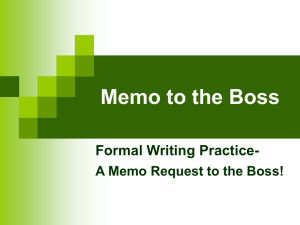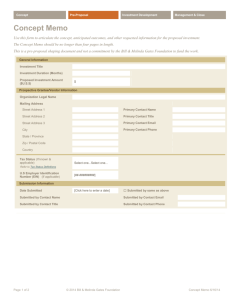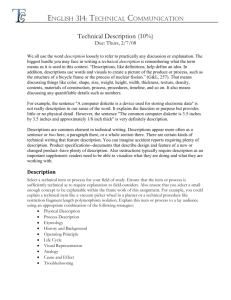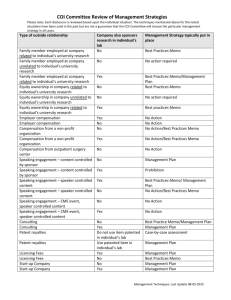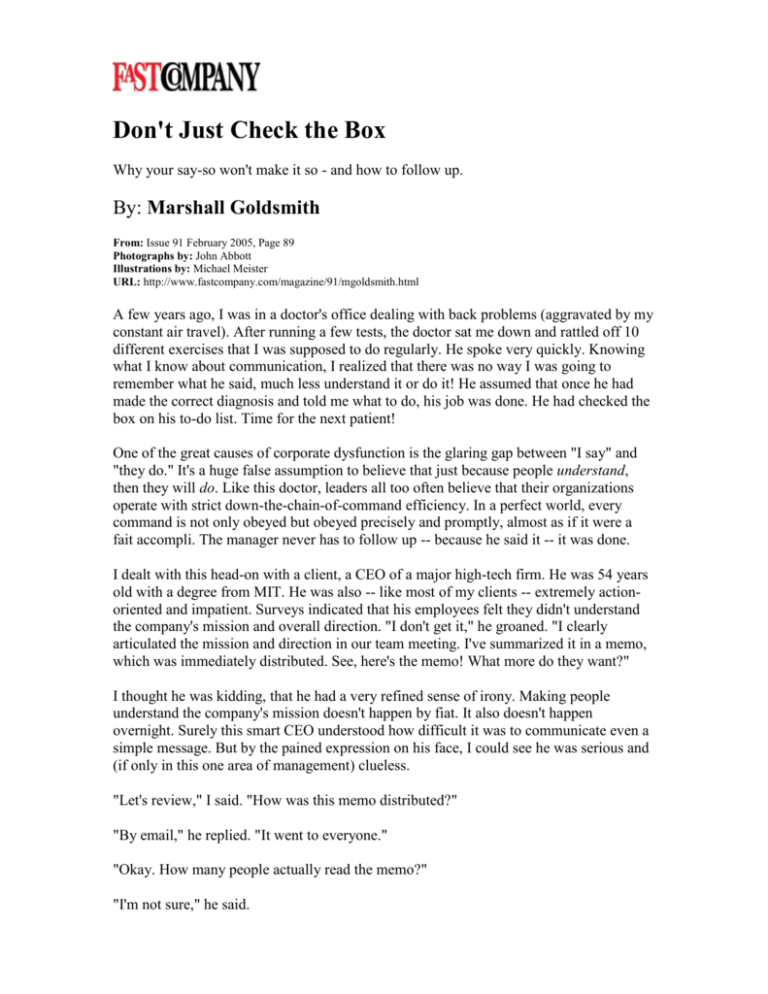
Don't Just Check the Box
Why your say-so won't make it so - and how to follow up.
By: Marshall Goldsmith
From: Issue 91 February 2005, Page 89
Photographs by: John Abbott
Illustrations by: Michael Meister
URL: http://www.fastcompany.com/magazine/91/mgoldsmith.html
A few years ago, I was in a doctor's office dealing with back problems (aggravated by my
constant air travel). After running a few tests, the doctor sat me down and rattled off 10
different exercises that I was supposed to do regularly. He spoke very quickly. Knowing
what I know about communication, I realized that there was no way I was going to
remember what he said, much less understand it or do it! He assumed that once he had
made the correct diagnosis and told me what to do, his job was done. He had checked the
box on his to-do list. Time for the next patient!
One of the great causes of corporate dysfunction is the glaring gap between "I say" and
"they do." It's a huge false assumption to believe that just because people understand,
then they will do. Like this doctor, leaders all too often believe that their organizations
operate with strict down-the-chain-of-command efficiency. In a perfect world, every
command is not only obeyed but obeyed precisely and promptly, almost as if it were a
fait accompli. The manager never has to follow up -- because he said it -- it was done.
I dealt with this head-on with a client, a CEO of a major high-tech firm. He was 54 years
old with a degree from MIT. He was also -- like most of my clients -- extremely actionoriented and impatient. Surveys indicated that his employees felt they didn't understand
the company's mission and overall direction. "I don't get it," he groaned. "I clearly
articulated the mission and direction in our team meeting. I've summarized it in a memo,
which was immediately distributed. See, here's the memo! What more do they want?"
I thought he was kidding, that he had a very refined sense of irony. Making people
understand the company's mission doesn't happen by fiat. It also doesn't happen
overnight. Surely this smart CEO understood how difficult it was to communicate even a
simple message. But by the pained expression on his face, I could see he was serious and
(if only in this one area of management) clueless.
"Let's review," I said. "How was this memo distributed?"
"By email," he replied. "It went to everyone."
"Okay. How many people actually read the memo?"
"I'm not sure," he said.
"Of those who read the email, how many do you think understood the message?"
He thought for a second and said, "I don't know."
"Of those who understood it, how many actually believed it was serious - not just PR
hype?"
He shook his head.
"Of this dwindling group of believers, how many remembered it?"
Another sorry head shake.
"That's a lot of unknowns for something you regard as vital to your company's existence,"
I said. "But that's not the worst part. Once you eliminate all those people -- and it's quite
possible there aren't many people left -- how many people do you think will change their
behavior based upon the memo? How many will begin living and breathing the
company's mission because of your memo?"
The CEO just grimaced and shrugged his shoulders.
I tried to revive his spirits by pointing out that the deeper issue was his mistaken belief
about communication, not this memo.
"The only thing you're guilty of," I said, "was that you checked the box. You thought
your job was done when you articulated the mission and wrote the memo, just one more
item on your to-do list. You moved on. Mentally, you smiled and said, 'Next!' "
Like most extremely busy leaders, this CEO wanted to believe that after he
communicated direction, people heard him, understood him, believed him, and then
executed. I can understand why executives persist in thinking this way. We all want to
believe that our comments have great meaning. We usually assume that the people
around us are smart, and they can understand what we're saying and see the value of our
remarks. We're often busy and overcommitted. We all wish we could just move on to the
next item on our list.
The good news for every manager, including my CEO friend, is that this false belief has a
simple cure. It's called "follow-up." After communicating, follow up to make sure that
people really understand, talk with them to get a read of their buy-in, and involve them to
make sure that they're committed to execution. Follow-up may take a little time, but it's
less than the time wasted on miscommunication.
If you're just checking the box, add one more item to your to-do list: Start changing your
ways.
Marshall Goldsmith (Marshall@MarshallGoldsmith.com) is corporate America's
preeminent executive coach and founder of Marshall Goldsmith Partners.
Copyright © 2004 Gruner + Jahr USA Publishing. All rights reserved.
Fast Company, 375 Lexington Avenue.,New York , NY 10017



